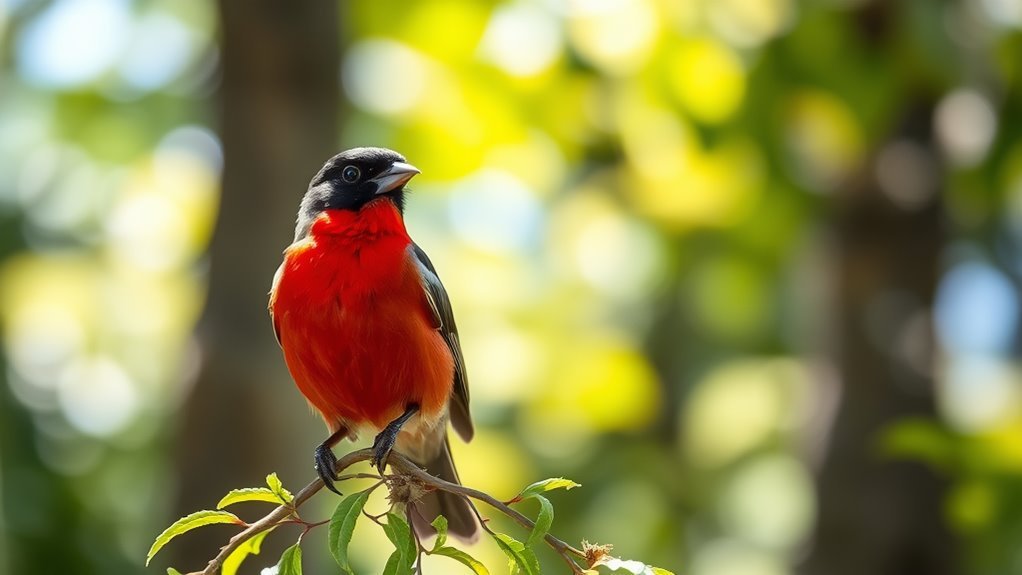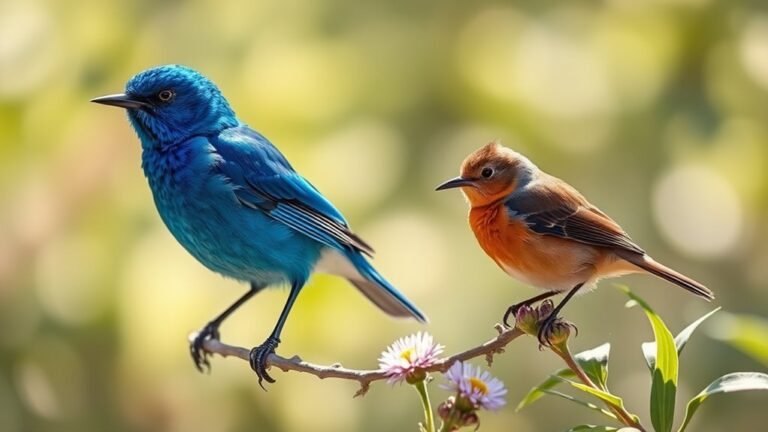12 Small Red Birds That Look Similar to Cardinals
Small red birds can often be confused with cardinals because of their bright colors. House Finches and Purple Finches, for example, have similar red plumage but differ in size and behavior. Knowing these differences can improve your birdwatching skills. Each species has unique traits that help them thrive in different habitats. Let's look at these interesting birds and learn how to tell them apart.
Key Takeaways
- House Finches are social birds with thick bodies and conical bills. Their similar colors can confuse people with cardinals.
- Purple Finches have bright feathers and live in forests. They are well-liked by birdwatchers for their melodic songs.
- American Robins are known for their bright orange-red chests. They are friendly foragers and adapt to many habitats.
- Scarlet Tanagers are bright red birds found in deciduous forests. They are recognized for their sweet songs and distinctive flight.
- Vermilion Flycatchers are vibrant red birds. They prefer open, dry areas and are known for their energetic flying.
House Finches

House Finches have stout bodies and conical bills. Birdwatchers often confuse them with vibrant cardinals. Learning about house finch behavior can improve your birdwatching experience.
These birds are social and usually travel in flocks. They sing a melodious song that varies in style and complexity.
House finches adapt their diet based on what food is available. They prefer seeds and fruits but will eat bits of human food as well. This flexibility helps them thrive in urban areas.
Watching how they find food can help you appreciate their adaptability. By learning about house finches, you can connect more deeply with nature around you.
Purple Finches
Purple Finches have bright plumage and resemble cardinals, making them popular among birdwatchers. They live in mixed woodlands, shrubby areas, and suburban gardens, showing a range of habitats.
These birds eat seeds and fruits, and they also consume insects during breeding season. Listen for their songs, which help them establish territory and attract mates.
Outside of breeding periods, Purple Finches usually gather in small flocks. Learning about their habitats and behaviors can enhance your appreciation for these birds and connect you to the birdwatching community.
American Robins

American Robins have bright orange-red breasts and sing lovely songs. People often confuse them with cardinals because of their color.
These birds are social and like to forage in groups. They find food by using their sharp eyesight to spot worms and insects.
For nesting, American Robins prefer open areas and often build their nests in trees and shrubs. They use grass, mud, and other materials to create their nests.
This ability to adapt helps them live in different environments. Bird watchers enjoy observing American Robins in both cities and countryside, appreciating their beauty and lively presence.
Scarlet Tanagers
Scarlet Tanagers are bright red birds that stand out from cardinals. They've vivid crimson bodies and black wings.
These birds live in deciduous forests and shrubby areas in eastern North America. They prefer mature woodlands where they find insects and berries, which are important for their survival.
You may notice that Scarlet Tanagers often stay hidden in the leaves. They sing a sweet, whistled song that carries through the trees.
Watching their unique flight patterns and behaviors can deepen your appreciation for these beautiful birds. Learning about Scarlet Tanagers can enhance your connection to nature and fellow bird watchers.
Vermilion Flycatchers

Vermilion Flycatchers are bright red birds that look like cardinals but belong to a different family. They live in open, dry areas, such as grasslands, deserts, and riverbanks, where the climate is warm.
These birds have energetic behaviors that make them interesting to watch. They fly acrobatically, catching insects in mid-air. You can often see them perched on low branches or fence posts.
They're very territorial, especially during breeding season.
Summer Tanagers
Summer Tanagers are bright birds that can confuse people trying to identify them. They often look like red-feathered species, such as cardinals. These birds live in summer habitats, thriving in open woodlands and areas with many trees.
Males have vibrant red feathers, which can mislead observers into thinking they see a cardinal. However, Summer Tanagers have a unique, melodic song and a sturdier body shape.
In terms of diet, Summer Tanagers mainly eat insects, including bees and wasps, and ripe fruits. They catch prey in midair and sometimes pick insects directly from branches.
Red Crossbills

Red Crossbills are small red birds known for their unique bill shape and feeding habits.
They're often found in coniferous forests, where they pry open conifer cones to access seeds. This ability helps them thrive in areas with pine, spruce, and fir trees.
Unlike many small birds, Red Crossbills are nomadic and follow food sources rather than stay in one place. This behavior shows their adaptability to changes in their environment.
Observing Red Crossbills can enhance your birdwatching experience and connect you with nature.
Pyrrhuloxia
The Pyrrhuloxia resembles a cardinal but has a unique look with gray and red feathers. This bird is popular among birdwatchers. It mainly lives in dry areas like desert scrub and thorny woodlands in the southwestern United States and Mexico.
Here are key details about the Pyrrhuloxia:
- Diet: It eats seeds, fruits, and insects, adjusting its diet based on what's available.
- Habitat: The Pyrrhuloxia prefers places with thick vegetation and shrubs, which provide good nesting spots.
- Behavior: This bird sings beautiful melodies and uses its songs to communicate and mark its territory.
Learning about these traits helps you appreciate the Pyrrhuloxia, making your birdwatching experience more enjoyable.
Rose-breasted Grosbeaks

Rose-breasted Grosbeaks are small, colorful birds that resemble cardinals. Males have striking black and white feathers with a bright rosy breast. These birds are very noticeable during their breeding season. They perform courtship displays and sing long, melodic songs to bond with their partners.
You can find them in deciduous and mixed forests, where they build nests high in trees.
Rose-breasted Grosbeaks mainly eat seeds, fruits, and insects. They use their strong beaks to crack open hard seeds.
Watching these grosbeaks can increase your appreciation for birds and help you understand their role in nature.
Hepatic Tanager
Hepatic Tanagers are beautiful birds known for their reddish-brown feathers. They live mainly in subtropical and tropical forests. These birds are social, especially during breeding season, which makes them enjoyable to watch.
- Diet: Hepatic Tanagers eat fruits and insects, which provide the energy they need.
- Vocalization: They make pleasant calls that contribute to the sounds of their habitats.
- Breeding: They build nests in dense foliage to protect their young from predators.
Learning about Hepatic Tanagers helps you see their importance in nature. Knowing where they like to live can improve your chances of spotting them.
These birds can deepen your connection with nature and offer a delightful experience.
Crimson-collared Grosbeak
Crimson-collared Grosbeaks are colorful birds that attract attention with their bright red bodies and black heads and wings.
They live in thickets and open woodlands in Central America, often near fruiting trees and shrubs.
These birds are social and can be seen in pairs or small groups, searching for seeds and fruits.
Their unique, melodious calls can be heard throughout their habitat.
Learning about their habits and homes deepens our appreciation for nature and connects us to the diverse wildlife in their environment.
Chipping Sparrows
Chipping Sparrows are often confused with cardinals because of their bright colors and lively behavior. However, they've unique features that make them different. Their feathers, especially during breeding season, show a mix of rust and brown, unlike the cardinal's deep red color.
Chipping Sparrows prefer specific habitats. You can commonly find them in:
- Open woodlands and fields
- Residential areas with low shrubs
- Grasslands near water sources
By recognizing these traits, you can easily spot Chipping Sparrows in your area.
Both birds have a charming presence, but knowing the differences helps you appreciate the variety of birds around you. Enjoy watching these delightful sparrows as they fill your environment with life.
Frequently Asked Questions
How Can I Attract Small Red Birds to My Backyard?
To attract small red birds, put up bird feeders filled with quality seeds. Choose seeds that these birds like, such as sunflower seeds and millet. Plant native flowers and shrubs in your garden for shelter and food. Creating a friendly space will encourage these colorful birds to visit your backyard often. Enjoy watching them as they brighten your outdoor area!
What Do Small Red Birds Eat?
Small red birds mainly eat seeds such as sunflower and safflower. To attract these birds to your backyard, provide a mix of seeds that they enjoy. This variety can create a friendly environment for them.
Are These Birds Good for Pest Control?
These birds show different behaviors, but they are not effective for pest control. They mainly eat seeds and berries, which reduces their ability to control pest populations.
What Habitats Do These Birds Prefer?
Many birds prefer thickets and wooded areas for nesting. They thrive in places with plenty of shrubs and trees. These habitats provide the shelter and food they need to survive.
How Can I Identify Male and Female Red Birds?
To identify male and female red birds, look for color differences. Males usually have bright red feathers, while females have softer, more muted colors. Also, pay attention to their behavior. Males often show more boldness when defending their territory, especially during mating season. This can help you distinguish between the two sexes easily.

Ava is a bird enthusiast and nature lover who has spent countless hours observing and learning about the fascinating world of birds. With a passion for sharing her knowledge and inspiring others to appreciate the beauty of birds, Ava writes about her experiences and insights on avianadmirer.com.







